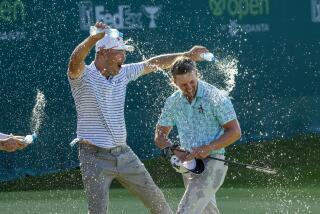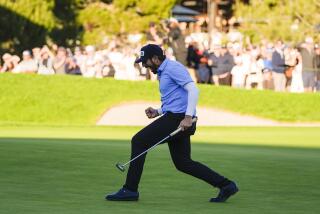Pavin’s Preference: Comfort Over Style : Former UCLA Golfer Goes Back to Old Swing and Is Getting Familiar Results
- Share via
COLUMBUS, Ga. — Given the choice between a textbook swing and a comfortable one, Corey Pavin will take what comes naturally.
Using that approach, Pavin won the Greater Milwaukee Open two weeks ago and finished eighth last week at the Southwest Golf Classic in Abilene, Tex.
After winning just $57,310 from May through September, the third-year pro from Los Angeles has won $83,837 the last two weeks and $296,266 overall this year.
Pavin, a former Camarillo resident who is 14th on the PGA money list, is among 156 golfers scheduled to tee off today in the 17th Southern Open at the par-70, 6,791-yard Green Island Country Club.
Defending champion Tim Simpson, who shot 16-under 264 to set a tournament record last year, is also entered. The winner will receive $63,000 from a purse of $350,000.
Back in swing with his backswing, Pavin is inspired by his performances over the past two weeks.
The former UCLA golfer said he has always had a two-piece backswing, in which his shoulders begin moving before his hands. That goes against standard golf teaching, which stresses that hands, shoulders and hips move at the same time.
So Pavin and Bruce Hamilton, the head pro at Las Posas Country Club in Camarillo who has been working with Pavin for nearly 12 years, switched to a one-piece backswing.
Pavin had some success early this year, winning the Hawaiian Open in February. But he was uncomfortable with the new backswing.
“I was trying to do something for me that was a major change and it just didn’t feel good,” Pavin said Wednesday after shooting a 4-under 66 in a pro-am event prior to the Southern Open. “That’s where all the problems were. It was just as effective physically, but mentally I just didn’t feel good over the shots and it just made me feel uncomfortable on the golf course.
“And the last thing you want to do is feel uncomfortable on the golf course. When you get over a shot, especially in a critical situation, and you don’t feel good, you’re most likely going to hit a bad shot.”
Pavin said such experimenting is part of the tinkering that takes place on the PGA Tour.
More to Read
Go beyond the scoreboard
Get the latest on L.A.'s teams in the daily Sports Report newsletter.
You may occasionally receive promotional content from the Los Angeles Times.










